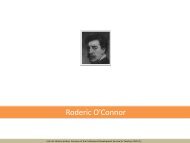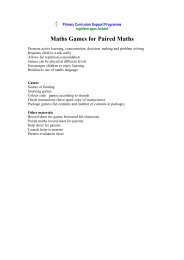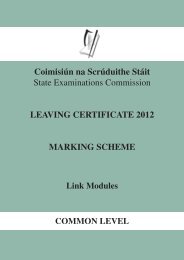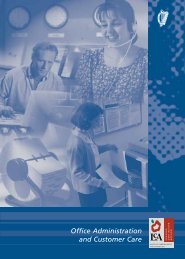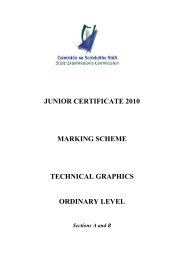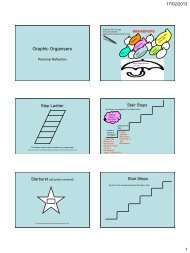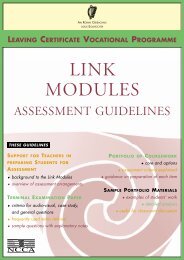What is Four in Balance? - PDST
What is Four in Balance? - PDST
What is Four in Balance? - PDST
Create successful ePaper yourself
Turn your PDF publications into a flip-book with our unique Google optimized e-Paper software.
We can describe research carried out on behalf of Kenn<strong>is</strong>net us<strong>in</strong>g the“knowledge pyramid” (Figure 2.1). The pyramid cons<strong>is</strong>ts of four levels:<strong>in</strong>spiration, ex<strong>is</strong>tence, perception, and evidence. Every <strong>in</strong>novation <strong>in</strong>education beg<strong>in</strong>s with an idea (<strong>in</strong>spiration). Some of these ideas canbe turned <strong>in</strong>to reality (ex<strong>is</strong>tence), and th<strong>is</strong> <strong>is</strong> where the <strong>Four</strong> <strong>in</strong> <strong>Balance</strong>conditions play a crucial role. The job of the researcher <strong>is</strong> to clarifywhether ICT will actually help produce the <strong>in</strong>tended benefits, whetherteachers, pupils and parents recognize its added value (perception), andwhether pupils <strong>in</strong> fact really learn more (evidence).In other words, we beg<strong>in</strong> build<strong>in</strong>g knowledge at the bottom of thepyramid, with an <strong>in</strong>spired idea as to how ICT can improve education. Theidea <strong>is</strong> put <strong>in</strong>to practice and research exam<strong>in</strong>es whether it has lived upto expectations. The research results can <strong>in</strong> turn lead to better ideas, andto a new or adapted bottom level, for example by extend<strong>in</strong>g successfulprojects to <strong>in</strong>clude a larger group or try<strong>in</strong>g them out under otherconditions, and by learn<strong>in</strong>g from projects that did not demonstrate theadded value of ICT.Example: Read<strong>in</strong>g with a computer program thatreads texts out loud (Kurzweil)Evidence – confirmed benefitsPupils who learn to read us<strong>in</strong>g the read-aloudsoftware are more motivated and self-confidentPerception – perceived benefitsTeachers and pupils are enthusiastic; pupilsare very motivated and feel more confidentEx<strong>is</strong>tence – implementationPupils <strong>in</strong> groups 4 to 8 use Kurzweil softwarewhen they like, like a pair of read<strong>in</strong>g glassesInspiration – ideaPupils weak <strong>in</strong> read<strong>in</strong>g let the computer readthem texts (compensat<strong>in</strong>g)16Figure 2.1: The knowledge pyramidThe knowledge pyramid <strong>is</strong> made up of four hierarchical levels; each succeed<strong>in</strong>glevel has greater evidentiary value. An example <strong>is</strong> given on the right (Luyten,2011b). Th<strong>is</strong> example concerns a school that uses a text-to-speech program tohelp dyslexic pupils with their read<strong>in</strong>g. The pupils can have the program readtexts out loud to them. In the example, research has confirmed the school’sexpectations. The results may lead to the program be<strong>in</strong>g used more widely.



